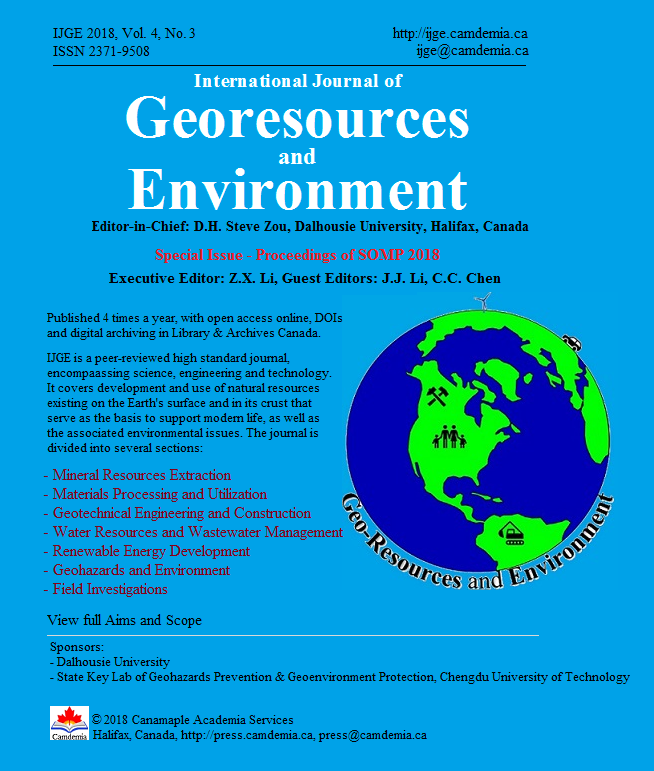A Framework of a 3D DCPCS Based on UWB Positioning in Underground Mining
DOI:
https://doi.org/10.15273/ijge.2018.03.025Keywords:
digital mine, 3D dynamic map, UWB positioning, comprehensive prevention and control systemAbstract
The real-time positioning and information feedback of the underground workers and equipment play a key role to achieve the safety digital mine because of the complex work scenario of non-coal mining in China, especially the injuries and collisions caused by the alternate operation between operators and vehicle equipment in underground mining. There are relevant requirements in the safety hazard called “six systems” which includes the personnel positioning, communication links, monitoring and controls, but the results are not prominent after investment and construction for its ambiguous definition of the scope of the standard and reasonable defects. This paper aims to study the application of Ultra-Wide Band (UWB) in underground personnel positioning, by comparing and analyzing traditional underground positioning technology. Combined with 3D scanning three-dimensional modeling technology, the UWB signal can also be used to construct 3D digital interactive underground map to enhance the accuracy of positioning information and the intuitiveness of monitoring perspective in control center. The framework of a 3D dynamic comprehensive prevention and control system (hereinafter referred to as 3D-DCPCS) based on UWB positioning in non-coal mining is proposed, depending on the supports of these technologies. Among them, UWB is a non-carrier communication technology. Its signal has strong anti-jamming performance and high transmission rate, which can improve the accuracy of real-time underground positioning. And the interactive 3D modeling technology is a new type of media, which can enhance the user's sense of reality through the transformation of pilot and perspective view. This framework of 3D-DCPCS is designed to have some specific modules, including user identity management module, underground three-dimensional map module, 3D interactive monitoring window module, underground risk assessment module, anti-collision module of personnel and vehicle, safety information statistical management module and other functional modules. This system can achieve the functions of different users' identity role management, underground safety risk identification and grade assessment, map of underground risk area, precise positioning and dynamic control of underground operators‘ vehicles, remote control and communication of underground equipment and personnel and 3D dynamic monitoring of underground operation scenarios. Meanwhile, these functions can be targeted to update through a period of security information statistical feedback. The system can be applied to comprehensive prevention and control monitoring of correlative complicated operating environment, by relating to the mentioned framework and specific situation of non-coal mine. It would be of practical values to improve the safety of underground personnel, standard safe operation of mechanical equipment and man-machine orderly cooperation in underground non-coal mine if it would be built and put into application.
Downloads
Published
Issue
Section
License
Copyright, Terms and Conditions
The International Journal of Geohazards and Environment (the Journal) is published by Canamaple Academia Services (the Publisher) online with open access, under a Creative Commons Attribution-Noncommercial license (CC-BY-NC) (http://creativecommons.org/licenses/by-nc/4.0/). Authors (the Authors) submitting papers (the Work) for publication in the Journal automatically agree to the following terms and conditions.
1. Under the license (CC-BY-NC), Authors give permission for others to share and reuse the Work, as long as the original source and author(s) are properly cited (i.e. a complete bibliographic citation and link to the Journal website) and the material is not used for commercial purposes. Any sharing or reuse must however indicate the original CC-BY-NC license terms of the work.
2. Authors transfer and assign to the Publisher all copyright in and to the Work. However Authors retain all proprietary rights except the copyright, related to the Work and also retain the rights a) to use, reproduce, distribute, and publicly display the Work in any medium in connection with the Authors‘ academic and professional activities, such as teaching, presentations and lectures, b) to create derivative works from the Work and to make full use of the Work in future research and publications, c) to authorize others to make any non-commercial use of the Work, d) to make both the pre-published and final-published versions available online in institutional and/or disciplinary repositories or on their own websites with a citation and link to the original paper published in the Journal.
3. Authors warrant that the Work is their original work, it is not copied from anywhere or anyone else, they are totally responsible for the authenticity, originality, validity and accuracy, and the facts and views are their own, that the Work contains no matter which is defamatory or infringes any literary or proprietary rights, intellectual property rights, or any rights of privacy, and that the Work has not been simultaneously submitted to any other journals or publishers. Authors further agree that their manuscripts whether accepted or rejected will not be returned and the rejected manuscripts will be disposed at the journal editor's discretion.
Disclaimer: The Publisher, the Journal and the editors accept no responsibility for statements or opinions expressed by authors. Use of information and materials in the Journal is the sole responsibility of users.


